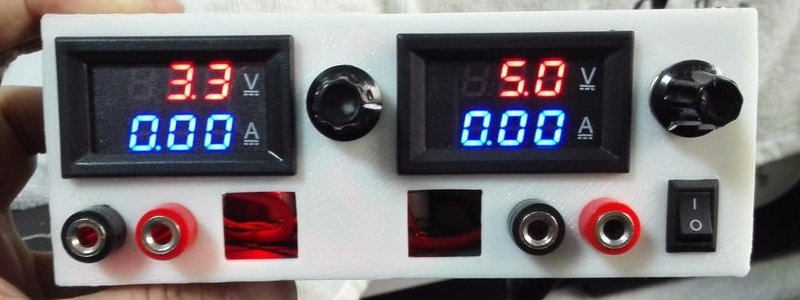You can never have too many power supplies around your workbench. It is easy to buy them or cobble something together for most purposes. But once in a while you see one that is simple and also looks good, like this one from [RegisHsu].
The project is simple since it uses off-the-shelf DC-to-DC converter modules, and good-looking LED meters to measure voltage and current. The dual supply can accept 5 to 16 V in (presumably from a wall transformer) and deliver 1.3 V to 15.5 V out at 2 amps. [RegisHsu] removed an adjustment pot from the converter board and replaced it with a 10-turn pot to allow voltage adjustment.
Given the parts, you probably don’t even need a wiring diagram. However, the part that brings it together is the 3D-printed case, which [RegisHsu] has on Thingiverse. We’ve looked at muti-turn pot replacements before, and this is hardly the first power supply project we’ve posted.
















Nice supply project!
I’ve used those same meters here, but they don’t like stray RF so they won’t read accurately while I’m using my ham radio gear. Oh, well. I only paid a few bucks for them.
Chokes in series, caps to ground, and a metal enclosure. Ham Radio 101 to the rescue.
But then the case wouldn’t be 3D printed and the whole project would have obviously been worthless
Or just line your 3D printed enclosure with Mu-Metal type panels or foil (3M does some similar flexible sheets that do a remarkable job at blocking RF… it’s like dynamat but for RF instead of AF). Your cost won’t be low, but you’ll get to do it how you want to and gain some experience with new materials.
I wonder if first circuit with shorts will destroy that converter module upon connection. Probably. I wouldn’t recommend using this one with prototype circuits, because errare humanum est and shorts might be hard to locate. There is reason, why even cheap, Chinese workbench supplies have current limiters and current adjustments. So my suggestion is to replace these modules with ones that have both voltage and current adjustments…
I would imagine the switching chip has short circuit protection.
All the same I prefer to have current limiting as it’s useful for things like steppers and lasers and is also good to protect your proto on those times when a 125Amp current limy just doesn’t cut it.
I used one of those cheap meters in my car battery charger, I got sick of dragging a multi-meter out.
I have been thinking of making a Bench PSU. I have a MOT that I removed the secondary from but I am not sure if that is what I want. I was going for multi-tap and multiple regulating transistors – one for each tap.
Linear PSU’s last forever so I don’t know if that’s the best option as I am old now and a Linear will last much much longer than me. I thought about some cheep Halogen light stepdowns (electronic) they might be good enough.
Make multiple windings, for 2, 4, 8, 16, 32 volts, Then use relays to connect them in any combination for required voltage, and then a linear regulator with P-MOSFET to minimize voltage drop. Add a DAC to control it, additional winding to power regulator and microcontroller that will control it and you will have a rather efficient supply, that won’t double as heater….
I clicked report rather than reply, sorry about that. I just wanted to say that those cheap halogen supplies tend to be high frequency AC (10kHz) rather than DC (I guess they just leave out the final rectifiers to save money). You can’t even use a cheap bridge rectifier, as it overheats due to the slow switching speed.
That’s a really good idea. I’ve just bought some buck convertor modules with adjustable V and I that would be great for this.
http://www.ebay.co.uk/itm/161805794868?_trksid=p2057872.m2749.l2649&ssPageName=STRK%3AMEBIDX%3AIT
It’s not going to have the same performance as a proper bench top PSU, but sometimes you just need lots of current, whether it’s dirty or not.
Hi,
I have bought some LM2596 DC-DC modules on Ebay. All had the National logo on them. At those times (when the national.com was not redirected to ti.com) National has not manufactured this chip. Suspicious… Ok, I tested the short circuit protection. The IC blow up. It was a fake. I ordered some from Texas and changed, since then it works fine.
Regards,
Csaba
I have had this happen too. Lots of fake transistors and IC’s come from China. If you need your design to meet known specifications then you must always order your parts from a factory authorized distributor.
Do a lot of people out there like to 3d print flat panels?